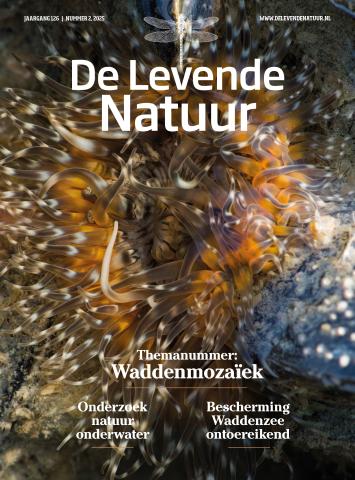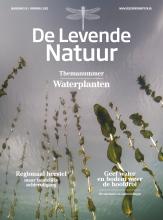De Levende Natuur nummer 2 van 2025 (English summary)
Afbeelding

De Levende Natuur
Under the surface of the Wadden Sea
The Wadden Sea is one of the largest tidal systems in the world. It is an important habitat and feeding ground for millions of birds, both breeding and migratory. Seals, porpoises, fish, benthic animals, and other species also make use of the area. However, what occurs beneath the water’s surface is not well understood. Therefore, in 2018, the research project ‘Waddenmozaïek’ was launched. In this special issue of De Levende Natuur, we highlight the most important results.
A clear picture of the blurred bottom of the Wadden Sea
Despite the international recognition of the Wadden Sea as a valuable nature reserve, half of its area, the subtidal part that is permanently submerged, is an ecological blind spot. What lives there is largely unknown. The Wadden Mosaic project mapped the benthic fauna, sediment composition and seafloor structure of the deeper parts of the Dutch Wadden Sea. It turns out that a varied world is hidden under the water surface, with 139 benthic species and substantial habitat heterogeneity.
Introducing hard substrates on the Wadden Sea bottom enhances biodiversity
Hard substrate occurs naturally in the subtidal Wadden Sea. Driftwood, pebbles and glacial erratics, shells: They are habitats for characteristic substrate-bound species. However, a lot of hard substrate has disappeared from the system. Using field experiments, the Waddenmozaïek project investigated the effect of different types and forms of hard substrate on the settlement success of benthic species. Our experiments show that reintroduction of hard substrate increases species richness and makes the food web more robust. Predation on young shellfish by shrimp, crabs and starfish was particularly high near the sea floor. Taller and more complex structures therefore provide relief from sedimentation and optimal protection from predators for mussels and other reef-forming shellfish species. When applying hard substrates to locally increase habitat heterogeneity and biodiversity, it is advised to preferably choose biodegradable materials that also have a historic relevance in the ecosystem.
Light is the primary driver for recovery of subtidal eelgrass
Only intertidal annual eelgrass exists in the Wadden Sea, as subtidal eelgrass (Zostera marina) has been extinct since the 1930s. Although recent success has been achieved in intertidal eelgrass restoration, subtidal eelgrass restoration is lagging. In this project, we successfully determined that there are still suitable areas available for eelgrass growth but that reintroduction of the subtidal, perennial morphotype is challenging. In a range of field and lab experiments, we established that several key challenges for restoration exist: Hydrodynamic stress, sediment instability, low light conditions, and macroalgae presence. Fluctuating salinity did not limit the growth of seagrass transplants. With this project, the very first steps towards subtidal eelgrass restoration in the Wadden Sea have been taken.
Protection of biological hot spots in the Wadden Sea is inadequate
The subtidal nature of the Dutch Wadden Sea is protected on paper, but hardly at all in practice. This is the conclusion drawn by the Waddenmozaïek project by combining maps of the protected areas with the calculated hotspots of both benthic communities and eider ducks. The actual protected area is limited to only 10% out of the 37% that is protected on paper, and there is only a 2% overlap of these protected locations with ecological hotspots. This greatly reduces the effectiveness of these protected areas.

